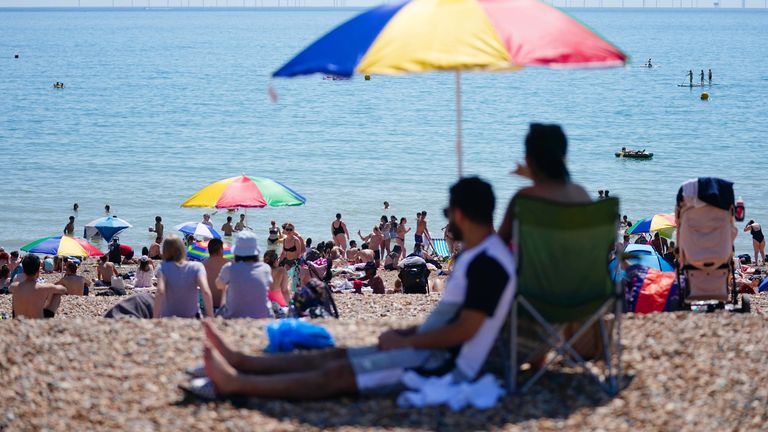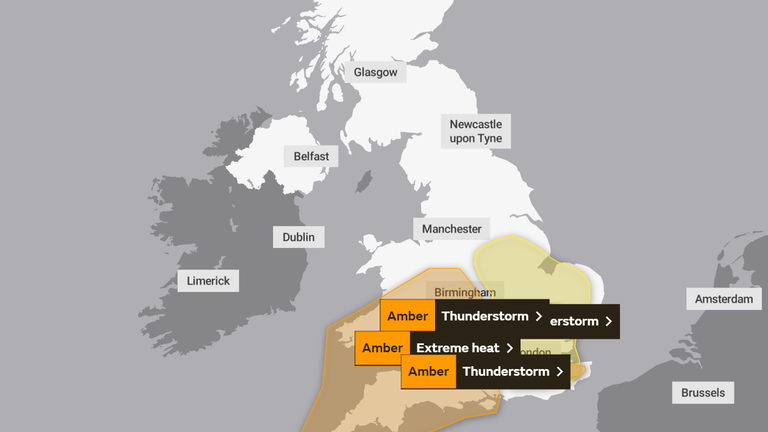UK weather: Thunderstorm and extreme heat warnings issued amid sweltering conditions across UK
The Met Office has issued amber and yellow thunderstorm warnings for large parts of central and southern England. It comes after it issued its first ever extreme heat warning, in place from Monday afternoon through to Thursday night, when temperatures are expected to drop.
Tuesday 20 July 2021 17:29, UK
The Met Office has issued amber and yellow thunderstorm warnings in addition to its first ever extreme heat warning today as the UK heatwave continues.
The Met Office has issued an amber thunderstorm warning for parts of East Anglia and the southeast in place until 7pm.
Heavy showers and thunderstorms are expected, bringing the risk of torrential rain, large hail, lightning and gusty winds.
A few places may see 40-60mm (4-6cm) of rain in two hours.
A yellow thunderstorm warning also covers a larger area of central and eastern England until the end of the day.
Grahame Madge, spokesman for the Met Office, said: "The lightning frequency could be quite intense...
"The thunderstorms we've got developing are purely because of the heat so they're not likely to affect the heat in anyway."
The Environment Agency has issued 16 flood alerts - meaning flooding is possible - in parts of London, Nottinghamshire and Derbyshire.
Heavy rain hit parts of East Anglia from around 4pm, with many people on social media recording severe hail storms and flooding.
It comes after the Met Office issued its first ever extreme heat warning.
It has been been applied to South Wales, West Midlands, southwest England and further east into Hampshire as far as the Isle of Wight and is in place until 23:59 Thursday.
Another heat warning has been applied to Northern Ireland from 8am tomorrow until the end of Friday, when temperatures are meant to drop.
Parts of the UK could reach 33C (91.4F) between Tuesday and Thursday, which is hotter than top European holiday destinations such as Marbella, Mykonos and Tenerife.
The mercury will remain above 31C (87.8F) during the week, with forecasters suggesting the next few days could be the hottest of the year.
Extreme heat warnings were introduced on 1 June into the National Severe Weather Warning Service (NSWWS), part of the Met Office which warns of the impacts of severe weather.
The warnings were brought in after consultations with Public Health England (PHE) and the UK's other health agencies, as well as other relevant groups, and are designed to highlight the downsides from heatwaves on things like health, infrastructure and other services.
The Welsh ambulance service declared an incident yesterday due to extreme pressures that has seen them receive 2,000 999 calls per-day for the last three days.
The trust said it was forced to declare a "business continuity incident" as the number of calls were up by 29% from the same Monday last year.
Director of Operations Lee Brooks said the move was "a sign of a serious situation".
He added: "Yesterday's heat coupled with the delays at hospitals meant we reached a point in the early evening where demand actually overtook our capacity to respond in a safe and timely way."
It comes as swathes of the UK endured soaring temperatures over the weekend.
All four of the home nations recorded their hottest day of the year so far - and Northern Ireland had its warmest day on record, as temperatures hit 31.2C in Ballywatticock, County Down, at 3.40pm on Saturday.
The previous highest temperature was 30.8C, reached on 12 July 1983 and 30 June 1976.
Sky meteorologist Christopher England said: "The Met Office has issued its first ever extreme heat warning, covering much of south Wales and south-west and central England. This has come about due to the increased frequency and severity of heatwaves
"The warnings go beyond the heat health alerts issued by PHE - which are primarily aimed at preparing the NHS and mostly apply to the more vulnerable - to include a much wider range of impacts.
"These include such things as more general health impacts like sunburn, swimming related incidents, damage to infrastructure - such as buckling of railway lines, melting tarmac, loss of power - and the increased risk of wildfires and coastal congestion.
"The warnings are also designed to cover the whole of the UK, whereas heat health alerts, which are widely picked up by the media, do not apply to the devolved administrations.
"It is also worth noting that unlike other Met Office warnings, these will only be issued as AMBER - be prepared - and RED - take actions."
According to PHE, there were 2,256 excess deaths during a summer heatwave in 2020 - the highest since records began.
And a number of deaths have already been recorded this week, with drownings in several locations around the UK.
Bob Ward, policy and communications director at the Grantham Research Institute on Climate Change and the Environment at LSE, said: "We are now in the middle of a natural disaster with hundreds of people dying across England and Wales due to the extreme heat."
He added: "An official review of the Heatwave Plan for England published last year by the London School of Hygiene and Tropical Medicine concluded that it had made no detectable impact on the number of people being hospitalised and dying from heat.
"More than 2,500 deaths were linked to heatwave conditions last summer, the highest number since the Heatwave Plan was introduced in 2004.
"We are now facing conditions that are similar to the period of hot weather that occurred in August 2020, resulting in more than 1700 deaths across England.
Subscribe to ClimateCast on Spotify, Apple Podcasts, or Spreaker
"Most of those who are dying are elderly or have underlying respiratory illnesses, living in houses and care homes that are prone to overheating.
"Many of these deaths could have been prevented if the government had implemented a national heat risk strategy."
Sky News has launched the first daily prime time news show dedicated to climate change.
The Daily Climate Show is broadcast at 6.30pm and 9.30pm Monday to Friday on Sky News, the Sky News website and app, on YouTube and Twitter.
Hosted by Anna Jones, it follows Sky News correspondents as they investigate how global warming is changing our landscape and how we all live our lives.







